| 1981 1987: Publisher of Coffee-Table Books |
|
1981-1987
Founded, with Patrick Dufour, director of the consulting society Copexen, Hologramme Publishing Cy dedicated to the publication of Beautiful Books.
 Hologramme's teams. Hologramme's teams.
The publishing company was, in fact, founded, because of the publication of the book which I directed, edited, wrote, illustrated, promoted and sold, on The Electronic Epoch. A journalist published the following article in the magazine Express :
|
« How to impose a very ambitious book in which nobody had faith? By bypassing the traditional editing business and creating her own publishing company. That is precisely what did Elizabeth Antébi, has done. She is the author of The Electronic Epoch , an art book that is also a global history of the modern sciences. The publishing company that she manages with Patrick Dufour is called Hologramme. Elizabeth, 37 years old, with a grey and sharp glance in a fragile face, has already written a book on magic in the West, and another on mental hospitals in the Soviet Union. A way to exert her writing. ‘I wanted to tell for the first time the true story of these pioneers of electronics, and that amazing adventure, from the invention of the tube to the chip.’ Hologramme has printed 15 000 copies of her Epoch, released simultaneously in the States and in France. » Marie-Laure de Léotard, L’Express, 10th-16th December 1982. |
From the very beginning, I was in charge of this lavishly illustrated collection (more than 400 photos and drawings) on the popularization of the sciences and technology: this book on Electronics was the first published – in co-production with foreign publishers, American, English, Dutch, German, Japanese.
Each book was conceived as follows :
- A general text, in literary style, very simple, to explain complex notions,
- Archives and recent photos,

- Very technical insets, with drawings, written on a more scientific level by experts from many countries.

Two of the books in that collection I wrote myself, The Electronic Epoch and Biotechnology: Strategies for Life.
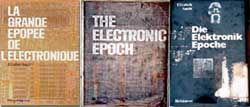 The first of them, The Electronic Epoch, was a very successful story, even if Thomson, who had agreed to sponsor the investigation in the beginning, had refused to continue to pay for something conceived under a journalistic and not an advertising angle. Half of the manuscript was already written, hundreds of photos were on my table, the dummy was done, when Thomson decided to withdraw his support. The director of Copexen left for the States and, as in a novel, called each of the publishing companies in the phone book, starting from the letter ‘A’: one hour before catching the plane back to Paris, he succeeded and sold the project to Van Nostrand Reinhold. That was how I was able to finish my investigation in the States and in Japan, edit the two books in two languages at the same time (one book in English for Van Nostrand, one book in French for Hologramme. At the following Frankfurt Fair we sold it to Birkhäuser, to be translated into German : The first of them, The Electronic Epoch, was a very successful story, even if Thomson, who had agreed to sponsor the investigation in the beginning, had refused to continue to pay for something conceived under a journalistic and not an advertising angle. Half of the manuscript was already written, hundreds of photos were on my table, the dummy was done, when Thomson decided to withdraw his support. The director of Copexen left for the States and, as in a novel, called each of the publishing companies in the phone book, starting from the letter ‘A’: one hour before catching the plane back to Paris, he succeeded and sold the project to Van Nostrand Reinhold. That was how I was able to finish my investigation in the States and in Japan, edit the two books in two languages at the same time (one book in English for Van Nostrand, one book in French for Hologramme. At the following Frankfurt Fair we sold it to Birkhäuser, to be translated into German :
 Birkhäuser Catalogue. Birkhäuser Catalogue.
Then, Claude Dugas, who worked at Thomson, introduced me to his friend, Pierre Aigrain, newly appointed Advisor for the President, and Aigrain decided immediately to buy thousands of books as business gifts. At the same time, Schlumberger had distributed the book for the New Year, to its executives, so that they could have a general idea of the world in which they were competing:Ce fut alors que Claude Dugas, de Thomson, me présentanommé conseiller du président de Thomson, qui décida de nous acheter des milliers de livres comme cadeau d’entreprise, avec introduction du Président. De même l’entreprise Schlumberger distribua le livre pour le Nouvel An à ses cadres, pour leur donner une idée globale du monde dans lequel ils évoluaient :
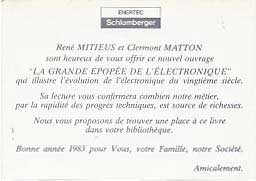 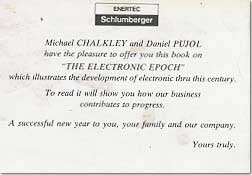 « M.C. and D.P. have the pleasure to offer you this book on THE ELECTRONIC EPOCH wich illustrates the development of electronic thru this century. To read it will show you how our business contributes to progress. A successful new year to you, your family and our company. Yours truly.” « M.C. and D.P. have the pleasure to offer you this book on THE ELECTRONIC EPOCH wich illustrates the development of electronic thru this century. To read it will show you how our business contributes to progress. A successful new year to you, your family and our company. Yours truly.”
For each book in the collection, I discussed the general outline, got in touch with the specialists for the assembly of the technical insets ( written by Nobel Prize winners, Academicians, business directors, even by inventors), dealt with the translations, chose the illustrations, negotiated the co-productions, dealt with marketing and sales to the firms with an introduction for the President and various other kinds of presentations, in divers languages, with cards or/and special packages. Little by little, I learned the job of Public Relations.
For the publication of The Electronic Epoch, I was invited to one of the biggest Bookseller chains, FNAC, to a cycle of conferences, on the following theme: "Revolutions in industry : we know that we have to inform people! As early as the 1920s, German writer Ernst Jünger, in his book The Worker, denounced the obsession of an industrial mobilization. He was not against industrial progress, which would be foolish, but warned people not to lose on the way, something very important, a way of looking at the world. Therefore, business people published books or articles on their “philosophy of enterprise”. But now, it seems that everything becomes much more complicated and that High Tech is more and more abstract. Is it any longer possible not to “read” the world in mathematical language?”
 Biotechnology: Strategies for Life was the second title of the collection. It was sold in the Netherlands, where the Preface was written by Prince Klaus, the husband of the queen, and was also published in the States by MIT Press (photo, on the left), and in Japan (photo, on the right):: Biotechnology: Strategies for Life was the second title of the collection. It was sold in the Netherlands, where the Preface was written by Prince Klaus, the husband of the queen, and was also published in the States by MIT Press (photo, on the left), and in Japan (photo, on the right)::
Cocktail party at the Ministry of Research and Industry (photos)
 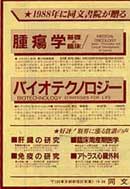
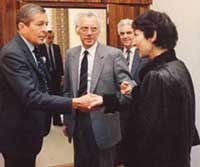  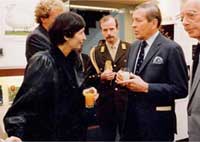
In 1984, the Director of the publishing company Natuur und Techniek introduced E. Antébi to Prince Klaus of the Netherlands, who wrote the preface of the Dutch version of the book on Biotechnologies that she had written and edited..
Published in English by MIT Press, Boston, in Japanese by Dobunshoin, Tokyo, in Dutch by Natuur und Techniek, Maastricht/Brussels, this book asks a very topical question : « Could one create Life in a laboratory ? » It tells the adventure of clones, genetically modified organisms, the incredible discovery of DNA, of restriction enzymes, the appearance of the first chimeras. It tells how scientists are using bacteria in industrial functions.
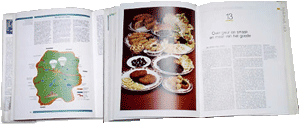 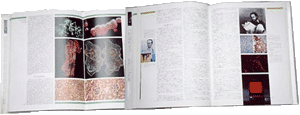
Then, seduced by the style of the first books of the collection, industrialists sponsored the publication of books such as Blood Plaquettes, by Maurice Moriau, University of Louvain, and Electricity by Nicolas Skrozky (I oversaw this project and found all the photos and illustrations).
 
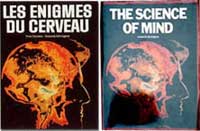 The Science of Mind (MIT Press, 1987) The Science of Mind (MIT Press, 1987)
 was the last book that I produced and edited in that collection, and Hologramme, having financial problems, sold it to Bordas in France, MIT Press in the States. I found the author, Kenneth Klivington, in San Diego, I did all the iconography, I chose the experts in each country. On that project, I also worked for a Japanese Publisher, found through our Japanese printer, whose two representatives, T. Wakizaki and my translator, Yoshiko Ohtagaki, advised me on how to deal with people in Japan. was the last book that I produced and edited in that collection, and Hologramme, having financial problems, sold it to Bordas in France, MIT Press in the States. I found the author, Kenneth Klivington, in San Diego, I did all the iconography, I chose the experts in each country. On that project, I also worked for a Japanese Publisher, found through our Japanese printer, whose two representatives, T. Wakizaki and my translator, Yoshiko Ohtagaki, advised me on how to deal with people in Japan.
 Frank Satlow, the director of MIT Press, who had already published my book on Biotechnology, sent me immediately the following letter : Frank Satlow, the director of MIT Press, who had already published my book on Biotechnology, sent me immediately the following letter :
 Dear Elizabeth, The Klivington book recently arrived and I must tell you that it is absolutely exquisite; in fact, it’s one of the most beautiful books I have seen. You did a fantastic job, baby! (we have sold 3000 copies on book order already). Dear Elizabeth, The Klivington book recently arrived and I must tell you that it is absolutely exquisite; in fact, it’s one of the most beautiful books I have seen. You did a fantastic job, baby! (we have sold 3000 copies on book order already).
|



